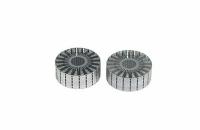
Firstly, one of the primary advantages of flexible cores in special transformers is their excellent magnetic properties. Compared to traditional rigid cores, flexible cores exhibit lower hysteresis losses and higher magnetic permeability, enabling transformers to effectively reduce energy loss and improve operational efficiency, especially in high-frequency operations. Special transformers often operate under specific conditions, such as high-frequency, high-temperature, or low-temperature environments. The magnetic performance of flexible cores stands out under these conditions. This makes flexible cores especially suitable for use in power electronics, communication devices, and rail transportation, broadening their application prospects.
Secondly, flexible cores have good machinability, allowing customization and adjustment based on specific needs. In special transformers, cores often need to be selected according to electrical parameters, operating environments, and space constraints. Due to their excellent flexibility, flexible cores can more easily adapt to complex design requirements, providing more versatility in the customized design of special transformers. Especially in applications that require high power density and miniaturization, flexible cores can effectively optimize the size and weight of the transformer, meeting modern industry demands for equipment miniaturization and efficiency.

Thirdly, the shock resistance and durability of flexible cores are important advantages in special transformers. In certain demanding operating environments, such as those in ships, power transmission equipment, and high-voltage devices, transformers may face severe vibrations, shocks, and temperature variations. Flexible cores, due to their unique material structure and design, can effectively mitigate the impact of these external factors on transformer operation, ensuring the long-term stable performance of the equipment. This characteristic makes flexible cores excel in transformers that require high reliability.
In addition, flexible cores also offer excellent magnetic field uniformity and low noise characteristics. In special transformers, particularly in applications where noise is a concern (such as medical devices, precision instruments, etc.), the low noise properties of flexible cores make them an ideal choice. By optimizing the design of the core, the electromagnetic interference (EMI) of the transformer can be further reduced, improving the stability and service life of the equipment. This makes flexible cores irreplaceable in high-end applications that have strict requirements for noise and electromagnetic interference.
Finally, with the growing emphasis on environmental protection and energy conservation, flexible cores also offer better environmental performance. Compared to traditional core materials, the production process of flexible cores is more environmentally friendly, and their material recovery rate is higher. Globally, energy conservation, emission reduction, and environmental protection policies are becoming crucial to the development of the industry. Flexible cores, due to their smaller environmental impact during production and use, meet the requirements for sustainable development in the future, making them more competitive in the market for special transformers.
The silicon steel market was stable in the fourth week of January 2024
2024-01-31Hysteresis Loop Characterisation of Iron Core Materials at Extremely Low Temperatures
2025-03-11Control Technologies and Material Optimization for Eddy Current Losses in Iron Cores
2025-02-22Tips on 304 stainless steel pipe cleaning and maintenance
2020-12-21Influence of silicon steel material on transformer performance
2024-11-22Shanghai Nickel High Pressure Obvious, Stainless Steel Rise Waiting for New Opportunity
2020-12-09






